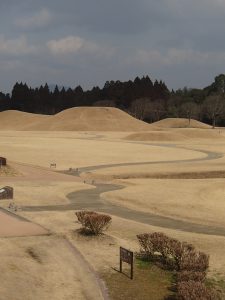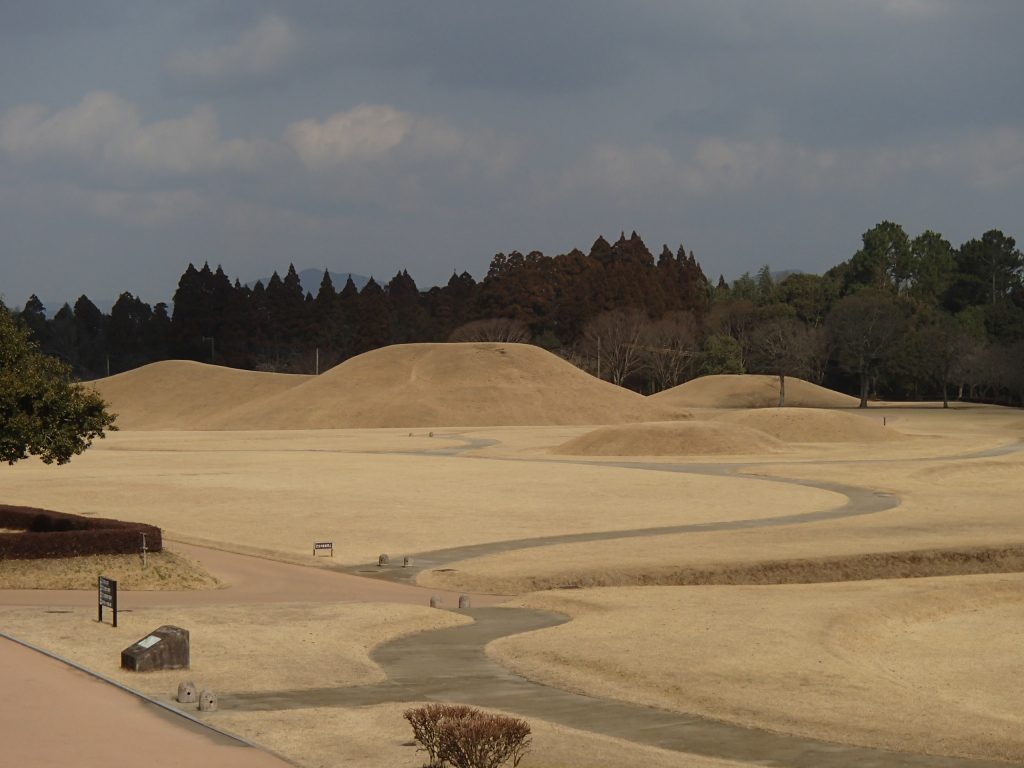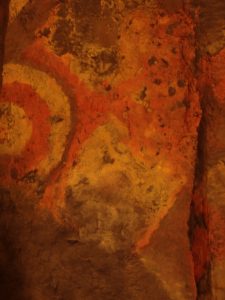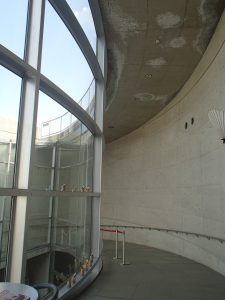Ancient Burial Mound Museum
The Kumamoto Prefectural Ancient Burial Mound museum in Yamaga celebrates the many and various decorated tumuli of Kumamoto.
 A tumulus is an ancient burial mound, there are approximately 200,000 of these burial mounds scattered over Japan all dating back from 400 to 700 AD. The era when these tumulus were built is known as the Kofun era in Japan and the tombs are famous for their distinctive keyhole shaped mounds. With the advent of buddhism in the 8th century the practice of tumulus building died out as quickly as it had started. The tumuli are important because they hold the key to the origins of the modern day Japanese.
A tumulus is an ancient burial mound, there are approximately 200,000 of these burial mounds scattered over Japan all dating back from 400 to 700 AD. The era when these tumulus were built is known as the Kofun era in Japan and the tombs are famous for their distinctive keyhole shaped mounds. With the advent of buddhism in the 8th century the practice of tumulus building died out as quickly as it had started. The tumuli are important because they hold the key to the origins of the modern day Japanese.
Of the thousands of tumuli only a few hundred are decorated and of the decorated ones the largest proportion are situated in the Kumamoto region particularly along the Kikuchi river basin. No one knows why the people of Japan suddenly began to build these burial tombs for their ancient kings but research now suggests that the practice of decorated tumuli began in Yatsushiro, in the south of the prefecture and then spread northwards to Kikuchi then Fukuoka then Nara and finally the far north east of Honshu, the area covering the whole of the Yamato kingdom – the progenitors of the current day Japanese.
The name ‘decorated tumulus’ may conjure up images of baubles and fairy lights (…or is that only me?), in fact the name refers to the paintings and carvings found on the coffin and within the burial chamber. These primitive, vibrant and powerful abstract designs, symbols and simple pictures are at strangely at odds with the exquisite treasures found within the tombs; intricately moulded bronze circular mirrors, finely crafted jewelery, delicate golden headware and pottery, swords, armour and riding tackle. Interestingly many of these treasures have origins from outside Japan, the glass beads coming from south asia, the mirrors from China and many of the other articles from Korea and though no one seems to want to shout about this in Japan …. there are also many similar tumuli in Korea. (this fact alone was enough to intrigue me)
So if you have any interest in ancient history the Kumamoto Decorated Tumulus Museum is well worth visiting, not least because its the most foreigner friendly museum I have yet to experience in Kumamoto, with plenty of exhibits having explanations in English. Yipppeee!
The Ancient Burial Mound Museum opened to great fanfare in the early 1990’s, the museum building being designed by one of Japan’s most famous architects: Tadeo Ando. Designed in the shape of a keyhole it is set on the Iwabaru plateau looking out over a group of tumuli, of which many are yet to be opened and investigated. One of them, the Yokoyama Tumulus can be entered with a guide between 09:30 and 16:30, ask at the museum for details
Sadly, it feels a little forlorn these days… this may be due to its rural location, a lack of funding or a lack of general interest in the subject matter. My feeling is that the museum does not promote or market itself enough. The museum content though not vast has recreations of the interiors of 12 of the many decorated kofun tombs that are scattered all over northern Kumamoto, as well as some of the objects found inside them, and even better it has English explanations and an English leaflet.
Unless you need a giggle or a 20 min nap give the free film a miss it obviously has not been updated since the early 90’s and there are no English subtitles.
The museum is child friendly with large grounds to explore, free entrance and some colouring and craft activities to do.
Admission:
The museum is free for children, 250 Yen for college students and 410 Yen for adults.
Closed On Mondays and between Dec 25th to Jan 4th.
Open From 09:30 – 17:15.
Getting there
The best way to get there is by car, head to Yamaga and just look for the English signs, it will take about an hour from Kumamoto city. The bus is also possible but it’s a bit of a hike when you get off. Take the bus to Yamaga and get off at Yoneda Nokyo Mae then it’s a 30 minute walk, or get off at Yamaga Bus Station and get a taxi – about 10 mins.
Travel tips
 The museum is pretty much in the middle of nowhere but just down the road from the main museum building you’ll find a dome shaped restaurant and local produce market which offers curry, dango shiru and a variety of other local fare. The purple blob in the picture is a new local variety of sticky potato – it was good! Across the road from the restaurant there is a farmer’s market.
The museum is pretty much in the middle of nowhere but just down the road from the main museum building you’ll find a dome shaped restaurant and local produce market which offers curry, dango shiru and a variety of other local fare. The purple blob in the picture is a new local variety of sticky potato – it was good! Across the road from the restaurant there is a farmer’s market.
There’s also a lotus pond, boasting lotuses cultivated from 1000 year old seeds.
The museum itself does not take that long to visit but if the weather is good take time to walk around and on top of the ancient burial mounds and explore the plateau area.
Feeling brave? Explore some of the many horizontal burial chambers built in to the hillsides on the eastern edge of the plateau.
As a foreigner you will probably be asked to complete a questionnaire after your visit, one request – even if you didn’t watch the film, please request they make a new one… yes, it really is that bad.
You could combine a visit to the museum with a stop off at Higo Minkan Mura, the mysterious Tonkararin tunnels, Yachiyoza Theatre, Yamaga town, the civil war museum at Tabaruzaka or the theme park Mitsui Greenland which is about 40 minutes drive to the north.
If you’d like to put a visit to the museum into a tour it’s best combined with the Samurai Swords tour or Yamaga and Kikuchi sights. Contact us for details.
[codepeople-post-map]
3085 Iwahara, Kao Machi, Yamaga shi, 〒861-0561
[button link=”” color=”red” size=”medium” type=”” shape=”pill” target=”_self” title=”back to top” gradient_colors=”|” gradient_hover_colors=”#353535|” accent_color=”” accent_hover_color=”” bevel_color=”” border_width=”1px” border_color=”” border_hover_color=”” shadow=”” icon=”fa-long-arrow-up” icon_divider=”yes” icon_position=”left” modal=”” animation_type=”0″ animation_direction=”down” animation_speed=”0.1″ class=”” id=””]back to top[/button]



